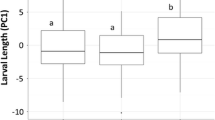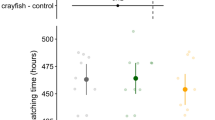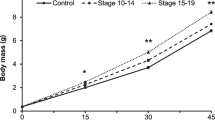Abstract
Most research on embryonic learning and behavior in aquatic vertebrates has focused on fitness benefits after hatching, but the ability of embryos to perceive and respond to environmental stimuli may also have immediate adaptive value. Here, we examined whether fathead minnow embryos, Pimephales promelas, detect and respond to cues indicative of predation risk, and whether the embryonic environment influences behavior after hatching. We compared the behavior of 5-day-old post-fertilization (dpf) embryos reared in the presence or absence of olfactory alarm cue, alone or in combination with the cues of a piscivorous predator (Bluegill sunfish, Lepomis macrochirus). Next, we reared larvae from the embryonic treatments to 21 dpf and tested them in two antipredator behavioral assays reflecting differences in the degree of immediate risk (predator avoidance vs attack evasion). Embryos that developed under perceived high-risk conditions exhibited reduced activity compared to those from low-risk environments. Larvae from high-risk environments also showed enhanced antipredator behavior, and evidence for embryonic predator learning. These data provide new insight into the learning capabilities and antipredator behaviors of aquatic vertebrate embryos.
Significance statement
Predators can have a dramatic influence on the fitness of individuals at all life stages, including before birth. During early development, as at other life stages, selection should favor the ability of individuals to perceive external cues indicative of predation and adjust their behavior appropriately. We reared embryos in the presence or absence of olfactory predation cues and observed behavior before and after hatching. Embryos from perceived ‘high-predation’ environments showed less-conspicuous behavior before and after hatching compared to those from ‘predation-free’ environments, suggesting that fish perceive, recognize, and respond to external risk cues before hatching—not just after, as is commonly shown. Embryos learned to identify a predator before hatching, but after hatching embryonic experience primarily affected behavior during the predator recognition and assessment stages of the predator–prey interaction, rather than during predator escape.





Similar content being viewed by others
Data availability
Data are available as supplementary materials, and from Dryad. https://doi.org/10.5061/dryad.02v6wwq4x.
Code availability
Not applicable.
References
Atherton JA, McCormick MI (2015) Active in the sac: damselfish embryos use innate recognition of odours to learn predation risk before hatching. Anim Behav 103:1–6. https://doi.org/10.1016/j.anbehav.2015.01.033
Benard MF, McCauley SJ (2008) Integrating across life-history stages: consequences of natal habitat effects on dispersal. Am Nat 171:553–567. https://doi.org/10.1086/587072
Blackiston DJ, Casey ES, Weiss MR (2008) Retention of memory through metamorphosis: can a moth remember what it learned as a caterpillar? PLoS ONE 3:e1736. https://doi.org/10.1371/journal.pone.0001736
Brown GE, Chivers DP, Elvidge CK, Jackson CD, Ferrari MCO (2014) Background level of risk determines the intensity of predator neophobia in juvenile convict cichlids. Behav Ecol Sociobiol 68:127–133. https://doi.org/10.1007/s00265-013-1629-z
Cashner M (2004) Are spotted bass (Micropterus punctulatus) attracted to schreckstoff? A test of the predator attraction hypothesis. Copeia 2004:592–598
Chapman BB, Morrell LJ, Benton TG, Krause J (2008) Early interactions with adults mediate the development of predator defenses in guppies. Behav Ecol 19:87–93. https://doi.org/10.1093/beheco/arm111
Chivers DP, Smith RJF (1994) The role of experience and chemical alarm signalling in predator recognition by fathead minnows, Pimephales promelas. J Fish Biol 44:273–285
Chivers DP, Smith RJF (1998) Chemical alarm signaling in aquatic predatory-prey systems: a review and prospectus. Ecoscience 5:338–352
Chivers DP, Wisenden BD, Smith RJF (1995) The role of experience in the response of fathead minnows (Pimephales promelas) to skin extract of Iowa darters (Etheostoma exile). Behaviour 132:665–674
Chivers DP, Kiesecker JM, Marco A, DeVito J, Anderson MT, Blaustein AR (2001) Predator-induced life history changes in amphibians: egg predation induces hatching. Oikos 92:135–142
Chivers DP, Mirza RS, Johnston JG (2002) Learned recognition of heterospecific alarm cues enhances survival during encounters with predators. Behaviour 139:929–938
Cox M, Ward JL, Matsuura M, Aing R, Schoenfuss H, Kohno S (2019) Estrone exposure interacts with temperature to alter predator evasion performance and systemic mRNA abundances. Sci Total Environ 692:519–528
Crane AL, Meuthen D, Thapa H, Ferrari MCO, Brown GE (2020) Early-life and parental predation risk shape fear acquisition in adult minnows. Anim Cogn 24:471–481. https://doi.org/10.1007/s10071-020-01439-3
Darmaillacq AS, Lesimple C, Dickel L (2008) Embryonic visual learning in the cuttlefish, Sepia officinalis. Anim Behav 76:131–134. https://doi.org/10.1016/j.anbehav.2008.02.006
De Block M, Stoks R (2005) Fitness effects from egg to reproduction: bridging the life history transition. Ecology 86:185–197. https://doi.org/10.1890/04-0116
Devlin E, Brammer J, Puyear R, McKim J (1996) Prehatching development of the fathead minnow Pimephales promelas Rafinesque. United States Environmental Protection Agency, Washington
Diamond KM, Lagarde R, Schoenfuss HL, Walker JA, Ponton D, Blob RW (2019) Relationship of escape performance with predator regime and ontogeny in fishes. Biol J Linn Soc 127:324–336. https://doi.org/10.1093/biolinnean/blz055
Divino JN, Tonn WM (2008) Importance of nest and paternal characteristics for hatching success in fathead minnow. Copeia 2008:920–930. https://doi.org/10.1643/CE-06-245
Domenici P, Blake RW (1997) The kinematics and performance of fish fast-start swimming. J Exp Biol 200:1165–1178
Donelan SC, Trussell GC (2018) Emergence synergistic effects of parental and embryonic exposure to predation risk on prey offspring size at emergence. Ecology 99:68–78
Eaton RC, Popper AN (1995) The octavolateralis system and Mauthner cell: interactions and questions. Brain Behav Evol 46:124–130. https://doi.org/10.1159/000113265
Eaton RC, Lee RKK, Foreman MB (2001) The Mauthner cell and other identified neurons of the brainstem escape network of fish. Prog Neurobiol 63:467–485
Engström-Öst J, Lehtiniemi M (2004) Threat-sensitive predator avoidance by pike larvae. J Fish Biol 65:251–261. https://doi.org/10.1111/j.0022-1112.2004.00448.x
Ferrari MCO, Chivers DP (2006) Learning threat-sensitive predator avoidance: how do fathead minnows incorporate conflicting information? Anim Behav 71:19–26. https://doi.org/10.1016/j.anbehav.2005.02.016
Ferrari MCO, Chivers DP (2009) Sophisticated early life lessons: threat-sensitive generalization of predator recognition by embryonic amphibians. Behav Ecol 20:1295–1298. https://doi.org/10.1093/beheco/arp135
Ferrari MCO, Trowell JJ, Brown GE, Chivers DP (2005) The role of learning in the development of threat-sensitive predator avoidance by fathead minnows. Anim Behav 70:777–784. https://doi.org/10.1016/j.anbehav.2005.01.009
Ferrari MCO, Manek AK, Chivers DP (2010a) Temporal learning of predation risk by embryonic amphibians. Biol Lett 6:308–310. https://doi.org/10.1098/rsbl.2009.0798
Ferrari MCO, Wisenden BD, Chivers DP (2010b) Chemical ecology of predator-prey interactions in aquatic ecosystems: a review and prospectus. Can J Zool 88:698–724. https://doi.org/10.1139/Z10-029
Fuiman LA, Magurran AE (1994) Development of predator defences in fishes. Rev Fish Biol Fish 4:145–183. https://doi.org/10.1007/BF00044127
Garcia TS, Urbina JC, Bredeweg EM, Ferrari MCO (2017) Embryonic learning and developmental carry-over effects in an invasive anuran. Oecologia 184:623–631. https://doi.org/10.1007/s00442-017-3905-5
Garcia TS, Bredeweg EM, Urbina J, Ferrari MCO (2019) Evaluating adaptive, carry-over, and plastic antipredator responses across a temporal gradient in Pacific chorus frogs. Ecology 100:e02825. https://doi.org/10.1002/ecy.2825
Gazdewich KJ, Chivers DP (2002) Acquired predator recognition by fathead minnows: influence of habitat characteristics on survival. J Chem Ecol 28:439–445. https://doi.org/10.1023/A:1017902712355
Gazzola M, Van Rees WM, Koumoutsakos P (2012) C-start: optimal start of larval fish. J Fluid Mech 698:5–18. https://doi.org/10.1017/jfm.2011.558
Gervais CR, Nay T, Brown C (2021) Friend or foe? Development of odour detection, differentiation and antipredator response in an embryonic elasmobranch. Mar Freshw Res 72:942–949. https://doi.org/10.1071/MF20108
Güell BA, Warkentin KM (2018) When and where to hatch? Red-eyed treefrog embryos use light cues in two contexts. PeerJ 6:e6018. https://doi.org/10.7717/peerj.6018
Guibé M, Poirel N, Houdé O, Dickel L (2012) Food imprinting and visual generalization in embryos and newly hatched cuttlefish, Sepia officinalis. Anim Behav 84:213–217. https://doi.org/10.1016/j.anbehav.2012.04.035
Hale ME, Long JH, McHenry MJ, Westneat MW (2002) Evolution of behavior and neural control of the fast-start escape response. Evolution 56:993–1007
Hardin JW, Hilbe JM (2012) Generalized estimating equations, 2nd edn. Chapman & Hall/CRC, New York
Horn ME, Ferrari MCO, Chivers DP (2019) Retention of learned predator recognition in embryonic and juvenile rainbow trout. Behav Ecol 30:1575–1582. https://doi.org/10.1093/beheco/arz116
Johnston IA (2006) Environment and plasticity of myogenesis in teleost fish. J Exp Biol 209:2249–2264. https://doi.org/10.1242/jeb.02153
Kasumyan AO (2004) The olfactory system in fish: structure, function, and role in behavior. J Ichthyol 44:180–223
Kelley JL, Magurran AE (2003) Learned predator recognition and antipredator responses in fishes. Fish Fish 4:216–226. https://doi.org/10.1046/j.1467-2979.2003.00126.x
Kempster RM, Hart NS, Collin SP (2013) Survival of the stillest: predator avoidance in shark embryos. PLoS ONE 8:e52551. https://doi.org/10.1371/journal.pone.0052551
Korwin-Kossakowski M (2012) Fish hatching strategies: a review. Rev Fish Biol Fish 22:225–240
Kusch RC, Chivers DP (2004) The effect of crayfish predation on phenotypic and life-history variation in fathead minnows. Can J Zool 82:917–921. https://doi.org/10.1139/Z04-066
Lehtiniemi M (2005) Swim or hide: predator cues cause species specific reactions in young fish larvae. J Fish Biol 66:1285–1299. https://doi.org/10.1111/j.1095-8649.2005.00681.x
Lindström J (1999) Early development and fitness in birds and mammals. Trends Ecol Evol 14:343–348
Lucon-Xiccato T, Crane AL, Ferrari MCO, Chivers DP (2020) Exposure to predation risk reduces lateralization in fathead minnows. Can J Exp Psychol 74:260–265. https://doi.org/10.1037/cep0000207
Macario A, Croft DP, Endler JA, Darden SK (2017) Early social experience shapes female mate choice in guppies. Behav Ecol 28:833–843. https://doi.org/10.1093/beheco/arx043
Marentette JR, Sullivan CA, Lavalle C, Shires K, Parrott JL (2015) Effects of multi-well plate incubation on embryo-larval development in the fathead minnow (Pimephales promelas). Comp Biochem Physiol C 167:173–182
Marks C, West T, Bagatto B, Moore F (2005) Developmental environmental alters conditional aggression in zebrafish. Copeia 2005:901–908
Mathis A, Smith RJF (1993a) Chemical alarm signals increase the survival time of fathead minnows (Pimephales promelas) during encounters with northern pike (Esox Lucius). Behav Ecol 4:260–265. https://doi.org/10.1093/beheco/4.3.260
Mathis A, Smith RJF (1993b) Chemical labeling of northern pike (Esox lucius) by the alarm pheromone of fathead minnows (Pimephales promelas). J Chem Ecol 19:1967–1979. https://doi.org/10.1007/BF00983800
Mathis A, Ferrari MCO, Windel N, Messier F, Chivers D (2008) Learning by embryos and the ghost of predation future. Proc R Soc Lond B 275:2603–2607. https://doi.org/10.1098/rspb.2008.0754
McGee MR, Julius ML, Vadja AM, Norris DO, Barber LB, Schoenfuss HL (2009) Predator avoidance performance of larval fathead minnows (Pimephales promelas) following short-term exposure to estrogen mixtures. Aquat Toxicol 91:355–361
Mezrai N, Arduini L, Dickel L, Chiao C-C, Darmaillacq, (2020) Awareness of danger inside the egg: evidence of innate and learned predator recognition in cuttlefish embryos. Learn Behav 48:401–410. https://doi.org/10.3758/s13420-020-00424-7
Mirza RS, Chivers DP (2000) Predator-recognition training enhances survival of brook trout: evidence from laboratory and fieldenclosure studies. Can J Zool 78:2198–2207. https://doi.org/10.1139/cjz-78-12-2198
Mourabit S, Rundle SD, Spicer JI, Sloman KA (2010) Alarm substance from adult zebrafish alters early embryonic development in offspring. Biol Lett 6:525–528. https://doi.org/10.1098/rsbl.2009.0944
Nelson AB, Alemadi SD, Wisenden BD (2013) Learned recognition of novel predator odour by convict cichlid embryos. Behav Ecol Sociobiol 67:1269–1273. https://doi.org/10.1007/s00265-013-1554-1
Ninness MM, Stevens ED, Wright PA (2006) Removal of the chorion before hatching results in increased movement and accelerated growth in rainbow trout (Oncorhynchus mykiss) embryos. J Exp Biol 209:1874–1882
O’Connor CM, Norris DR, Crossin GT, Cooke SJ (2014) Biological carryover effects: linking common concepts and mechanisms in ecology and evolution. Ecosphere 5:1–11. https://doi.org/10.1890/ES13-00388.1
Olivotto I, Cardinali M, Barbaresi L, Maradonna F, Carnevali O (2003) Coral reef fish breeding: the secrets of each species. Aquaculture 224:69–78
Otero Coronel S, Martorell N, Beron de Astrada M, Medan V (2020) Stimulus contrast information modulates sensorimotor decision making in goldfish. Front Neural Circuits 14:23. https://doi.org/10.3389/fncir.2020.00023
Oulton LJ, Haviland V, Brown C (2013) Predator recognition in rainbowfish, Melanotaenia duboulayi, embryos. PLoS ONE 8:e76061. https://doi.org/10.1371/journal.pone.0076061
Paradis AR, Pepin P, Brown JA (1996) Vulnerability of fish eggs and larvae to predation: review of the influence of the relative size of prey and predator. Can J Fish Aquat Sci 53:1226–1235. https://doi.org/10.1139/f96-051
Pechenik JA (2006) Larval experience and latent effects: metamorphosis is not a new beginning. Integr Comp Biol 46:323–333. https://doi.org/10.1093/icb/icj028
Pekár S, Brabec M (2018) Generalized estimating equations: a pragmatic and flexible approach to the marginal GLM modelling of correlated data in the behavioural sciences. Ethology 124:86–93. https://doi.org/10.1111/eth.12713
Pfeiffer W (1963) The fright reaction of North American fish. Can J Zool 41:69–77
Poisson A, Valotaire C, Borel F, Bertine A, Darmaillacq A-S, Dickel L, Colson V (2017) Embryonic exposure to a conspecific alarm cue triggers behavioural plasticity in juvenile rainbow trout. Anim Behav 133:35–45. https://doi.org/10.1016/j.anbehav.2017.09.013
Ramasamy RA, Allan BJM, McCormick MI (2015) Plasticity of escape responses: prior predator experience enhances escape performance in a coral reef fish. PLoS ONE 10:e0132790. https://doi.org/10.1371/journal.pone.0132790
Saint-Amant L, Drapeau P (1998) Time course of the development of motor behaviors in the zebrafish embryo. J Neurobiol 37:622–632
Sih A, Moore R (1993) Delayed hatching of salamander eggs in response to enhanced larval predation risk. Am Nat 142:947–960
Stoks R, De Block M, Slos S, Van Doorslaer W, Rolff J (2006) Time constraints mediate predator-induced plasticity in immune function, condition, and life history. Ecology 87:809–815
Suboski MD (1990) Releaser-induced recognition learning. Psychol Rev 97:271–284. https://doi.org/10.1037/0033-295X.97.2.271
Tollrian R (1995) Predator-induced morphological defenses: costs, life history shifts, and maternal effects in Daphnia pulex. Ecology 76:1691–1705
Van Allen BG, Rudolf VHW (2013) Ghosts of habitats past: environmental carry-over effects drive population dynamics in novel habitat. Am Nat 181:596–608. https://doi.org/10.1086/670127
Waldman B (1982) Quantitative and developmental analyses of the alarm reaction in the zebra danio, Brachydanio rerio. Copeia 1982:1–9
Ward JL, Cox M, Schoenfuss H (2017) Thermomodulation of anthropogenic estrogen exposure on a freshwater fish at two life stages. Horm Behav 94:21–32
Warkentin KM (1995) Adaptive plasticity in hatching age: a response to predation risk trade-offs. Ecology 92:3507–3510
Warkentin KM (1999a) Effects of hatching age on development and hatchling morphology in the red-eyed treefrog, Agalychnis callidryas. Biol J Linn Soc 68:443–470. https://doi.org/10.1006/bijl.1999.0325
Warkentin KM (1999b) The development of behavioral defenses: a mechanistic analysis of vulnerability in red-eyed tree frog hatchlings. Behav Ecol 10:251–262. https://doi.org/10.1093/beheco/10.3.251
Warkentin KM (2000) Wasp predation and wasp-induced hatching of red-eyed treefrog eggs. Anim Behav 60:503–510. https://doi.org/10.1006/anbe.2000.1508
Warkentin KM (2011a) Environmentally cued hatching across taxa: embryos respond to risk and opportunity. Integr Comp Biol 51:14–25. https://doi.org/10.1093/icb/icr017
Warkentin KM (2011b) Plasticity of hatching in amphibians: evolution, trade-offs, cues and mechanisms. Integr Comp Biol 51:111–127. https://doi.org/10.1093/icb/icr046
Weihs D, Webb PW (1984) Optimal avoidance and evasion tactics in predator-prey interactions. J Theor Biol 106:189–206. https://doi.org/10.1016/0022-5193(84)90019-5
Wisenden BD, Rugg ML, Korpi NL, Fuselier LC (2009) Lab and field estimates of active time of chemical alarm cues of a cyprinid fish and an amphipod crustacean. Behaviour 146:1423–1442. https://doi.org/10.1163/156853909X440998
Witt WC, Wen L, Lauder GV (2015) Hydrodynamics of C-start escape responses of fish as studied with simple physical models. Integr Comp Biol 55:728–739. https://doi.org/10.1093/icb/icv016
Acknowledgements
We thank the dedicated undergraduates that assisted with the maintenance of the experiment and testing, as well as Paul Venturelli and Mark Pyron for comments on an earlier version of the manuscript. The authors are grateful to two anonymous reviewers, whose comments and suggestions substantially improved the manuscript.
Funding
Funding for this project was provided by a Provost Start-Up Award from Ball State University to JLW.
Author information
Authors and Affiliations
Corresponding author
Ethics declarations
Ethics approval
All applicable international, national, and/or institutional guidelines for the use of animals were followed. Animal treatment and welfare procedures were performed in regulation with Ball State University’s Institutional Animal Care and Use Committee (1220881–17).
Consent to participate
Not applicable.
Consent for publication
All authors have read and approved submission of the manuscript.
Conflict of interest
The authors declare no competing interests.
Additional information
Communicated by C. C Ioannou.
Publisher's note
Springer Nature remains neutral with regard to jurisdictional claims in published maps and institutional affiliations.
Supplementary Information
Below is the link to the electronic supplementary material.
Rights and permissions
About this article
Cite this article
Crowder, C., Ward, J. Embryonic antipredator defenses and behavioral carryover effects in the fathead minnow (Pimephales promelas). Behav Ecol Sociobiol 76, 27 (2022). https://doi.org/10.1007/s00265-022-03136-2
Received:
Revised:
Accepted:
Published:
DOI: https://doi.org/10.1007/s00265-022-03136-2




